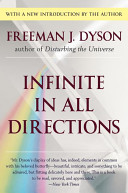Tangled Bank of the Primeval Cell
In our present state of ignorance, we have a choice between two contrasting images to represent our view of the possible structure of a creature newly emerged at the first threshold of life. One image is the replicator model of Eigen, a molecular structure tightly linked and centrally controlled, replicating itself with considerable precision, achieving ho-meostasis by strict adherence to a rigid pattern. The other image is the "tangled bank" of Darwin, an image which Darwin put at the end of his Origin of Species to make vivid his answer to the question, What is Life?, an image of grasses and flowers and bees and butterflies growing in tangled profusion without any discernible pattern, achieving homeostasis by means of a web of interdependences too complicated for us to unravel.
The tangled bank is the image which I have in mind when I try to imagine what a primeval cell would look like. I imagine a collection of molecular species, tangled and interlocking like the plants and insects in Darwin's microcosm. This was the image which led me to think of error tolerance as the primary requirement for a model of a molecular population taking its first faltering steps toward life. Error tolerance is the hallmark of natural ecological communities, of free market economies and of open societies. I believe it must have been a primary quality of life from the very beginning. But replication and error tolerance are naturally antagonistic principles. That is why I like to exclude replication from the beginnings of life, to imagine the first cells as error-tolerant tangles of {93} non-replicating molecules, and to introduce replication as an alien parasitic intrusion at a later stage. Only after the alien intruder has been tamed, the reconciliation between replication and error tolerance is achieved in a higher synthesis, through the evolution of the genetic code and the modern genetic apparatus.
The modern synthesis reconciles replication with error tolerance by establishing the division of labor between hardware and software, between the genetic apparatus and the gene. In the modern cell, the hardware of the genetic apparatus is rigidly controlled and error-intolerant. The hardware must be error-intolerant in order to maintain the accuracy of replication. But the error tolerance which I like to believe inherent in life from its earliest beginnings has not been lost. The burden of error tolerance has merely been transferred to the software. In the modern cell, with the infrastructure of hardware firmly in place and subject to a strict regime of quality control, the software is free to wander, to make mistakes and occasionally to be creative. The transfer of architectural design from hardware to software allowed the molecular architects to work with a freedom and creativity which their ancestors before the transfer could never have approached.
Notes:
Folksonomies: tangled bank
Taxonomies:
/technology and computing/hardware (0.452749)
/technology and computing/software (0.411767)
/science/social science/history (0.342341)
Keywords:
error tolerance (0.944681 (negative:-0.708999)), tangled bank (0.759895 (negative:-0.579123)), genetic apparatus (0.735861 (negative:-0.238416)), primeval cell (0.732561 (negative:-0.667284)), synthesis reconciles replication (0.720833 (neutral:0.000000)), free market economies (0.688364 (positive:0.207813)), natural ecological communities (0.686568 (negative:-0.549900)), modern genetic apparatus (0.681615 (neutral:0.000000)), alien parasitic intrusion (0.681447 (negative:-0.252790)), modern cell (0.657229 (positive:0.357215)), tangled profusion (0.656127 (negative:-0.261310)), life (0.626088 (positive:0.035830)), strict adherence (0.625432 (neutral:0.000000)), replicator model (0.621654 (neutral:0.000000)), considerable precision (0.618920 (positive:0.349498)), image (0.618847 (negative:-0.261310)), present state (0.618472 (negative:-0.667284)), error-tolerant tangles (0.617937 (neutral:0.000000)), possible structure (0.615096 (negative:-0.327618)), molecular structure (0.613060 (positive:0.487167)), discernible pattern (0.612241 (negative:-0.261310)), antagonistic principles (0.609467 (negative:-0.804023)), rigid pattern (0.609428 (neutral:0.000000)), vivid his answer (0.607497 (neutral:0.000000)), strict regime (0.604336 (positive:0.432677)), primary requirement (0.603359 (neutral:0.000000)), molecular species (0.602835 (neutral:0.000000)), primary quality (0.600862 (positive:0.522404)), molecular population (0.600814 (neutral:0.000000)), alien intruder (0.600570 (negative:-0.404743))
Entities:
Tangled Bank:Company (0.866402 (negative:-0.464297)), Darwin:OperatingSystem (0.397341 (negative:-0.418144)), free market:FieldTerminology (0.263470 (positive:0.207813))
Concepts:
Evolution (0.989752): dbpedia | freebase | opencyc
Charles Darwin (0.765480): dbpedia | freebase | opencyc | yago
DNA (0.751063): website | dbpedia | freebase | yago
Gene (0.672793): dbpedia | freebase
Molecule (0.640143): dbpedia | freebase | opencyc
Organism (0.621351): dbpedia | freebase
Natural selection (0.606140): dbpedia | freebase
History of evolutionary thought (0.536500): dbpedia | freebase





